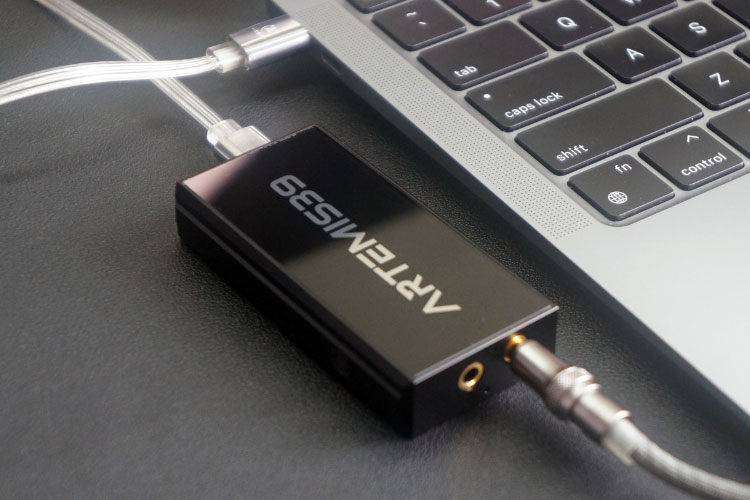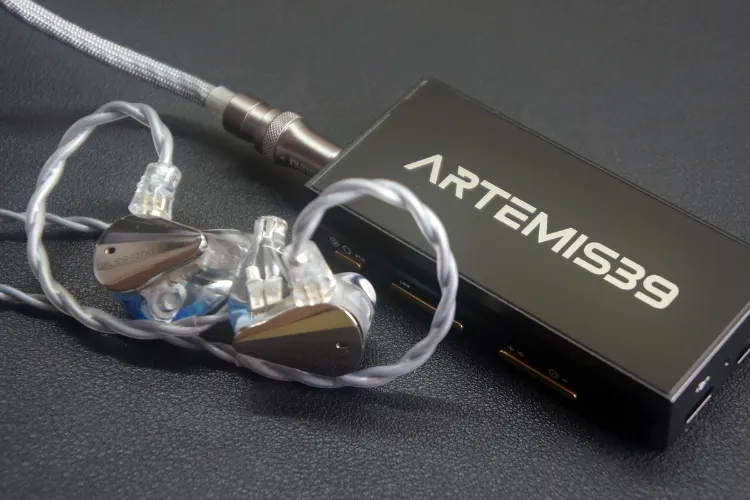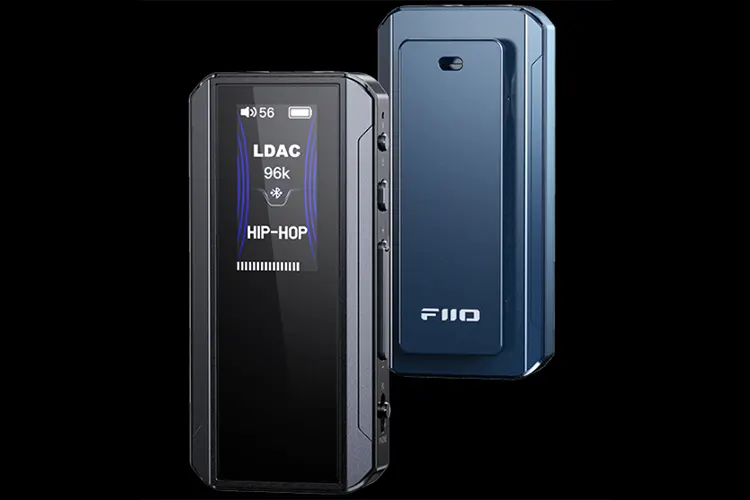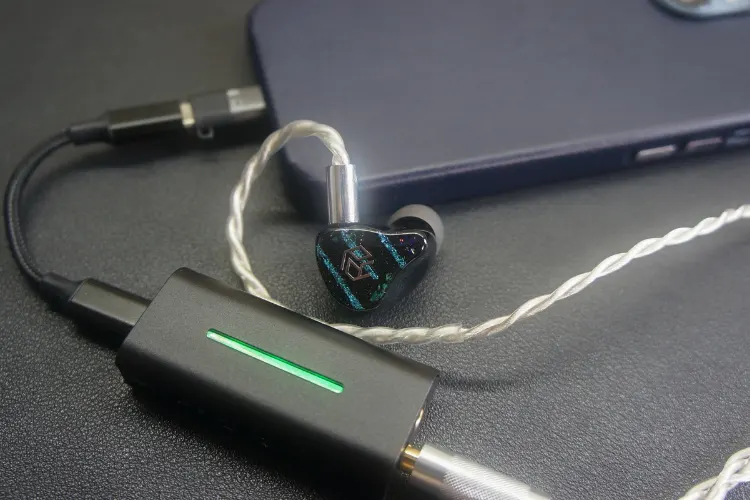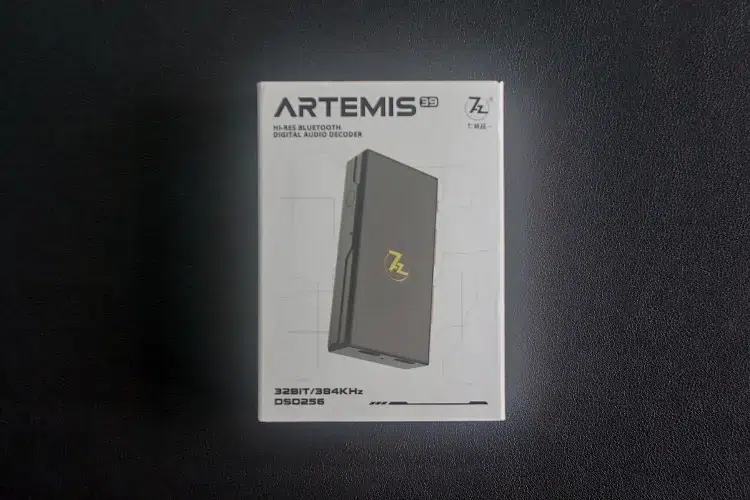Synergy
Power
The Artemis39 shows very solid output power, delivering 405mW into 32Ω via the 4.4mm balanced output and 320mW into 32Ω through the 3.5mm single-ended output.
Even through its single ended output, I found that the Artemis39 had no problem driving more demanding IEMs such as the Hidizs MP145 and the Moondrop Blessing 3.
Even on its SE output, the Artemis39 had enough headroom that ensured I was able to drive the IEMs to a listenable volume without any distortion.
The Artemis39 manages to drive full-sized headphones like the Sennheiser HD 580 through its 4.4mm output. It brought the Ananda to a comfortable listening level without maxing out the volume.
Among all the portable sources I’ve tried, the Artemis39 did the best job of preserving the treble region whilst minimizing distortion and sibilance.
I would still prefer driving my HD 580 through a desktop source like the FiiO K11 R2R, where instruments on both ends of the frequency response are extended much better, but the Artemis39’s performance is sufficient for me to consider listening to them wirelessly.
Its low signal-to-noise ratio makes the Artemis39 suitable for sensitive IEMs. Unlike other DAC/AMPs, such as the VE Megatron, I did not encounter any hissing when connecting IEMs to the 4.4mm outputs of the Artemis39.
Pairings
I found that the Artemis39 pairs best with IEMs that already have pleasing tuning out of the box but could benefit from the Artemis39’s power output.
In my testing, I found that 7Hz’s Aurora IEM paired best with the Artemis39, especially the 4.4mm balanced output that yielded better instrument separation performance.
Even though the tribrid Aurora did not fully maximize the Artemis39’s balanced power output, the improved staging and instrument separation made the Artemis39 my preferred pairing for the Aurora.
Similarly, the Moondrop Blessing 3’s stock neutral tonality was already one I found quite pleasing. Driving them with the Artemis39 through its SE output was sufficient to reach a listenable level without changing too much in the sound signature.
The Artemis39’s 405mW balanced output paired well with my Sennheiser HD 580’s. I would not recommend using the Artemis39 as one’s primary DAC/AMP for the HD 580 since it does not reach the same full extension as desktop units.
However, these were tradeoffs I was willing to make to listen to the HD 580 without being tethered to my desk.
Select Comparisons
FiiO BTR13
Technical
The BTR13 and the Artemis39 dongles have different DAC configurations. The BTR13 uses dual Cirrus Logic CS43131 DAC chips, while the Artemis39 comes with an ES9039Q2M DAC chip.
The Artemis39 can decode up to PCM 32BIT/384kHz, and DSD up to DSD25, while the FiiO can decode up to a lower 16BIT/96kHz.
Both the BTR13 and Artemis39 support Bluetooth, with both supporting AAC/SBC/aptX/aptX LL/ aptX HD/LDAC codecs.
The BTR13’s sole physical input is a USB-C female port used for both data and charging, while the more versatile 7Hz Artemis has dedicated charging and data ports, while also supporting Bluetooth input.
Both units have 3.5mm SE and 4.4mm BAL outputs. The BTR13 can output up to 220mW@32Ω balanced and 120mW@32Ω through its SE output. The Artemis39 can provide a significantly higher 405mW@32Ω balanced and 320mW@32Ω single-ended
Design
Both units have a similar elongated rectangle form factor with I/O on the top and bottom and controls on the lateral sides. However, the Artemis39 is substantially larger in every physical dimension, making it less portable and much heavier as well.
The Artemis39 is constructed from anodized metal wrapped around 2 glass panels, while the BTR13 has a plastic shell and a front crystal with a 0.96″ IPS LCD in front. The rear of the BTR13 houses a plastic clip to attach the unit to a bag strap, belt, or shirt.
The inclusion of a screen with UI makes the BTR13 significantly more versatile and user-friendly than the pricier Artemis39.
Performance
The BTR13 has a warmer sound presentation with significantly less detail and texture retrieval than the Artemis39.
The Artemis39 has a much stronger, deeper-hitting bass, while also being able to playback the nuance between different strikes of the bass drum and percussive instruments.
In comparison, drum strikes on the BTR13 come off one dimensional and devoid of the more nuanced texture on the Artemis39.
The BTR13’s warmer sound signature gives male vocals more body and a lusher sound signature, however, this comes at less detail retrieval and instrument separation compared to the Artemis39.
Especially with complex arrangements of string instruments, the BTR13 can blend these tones into what sounds like a solid wall of sound, while the Artemis39 expertly plays back the different layers in an easily distinguishable manner.
The treble presentation on the BTR13 feels somewhat veiled and lacks the clarity found in the Artemis39. With the Artemis39, there’s a noticeable improvement in resolution, allowing cymbals and snare hits to exhibit more sparkle and a better-defined decay.
Unlike the BTR13, which can become fatiguing due to its emphasis on snares and hi-hats, the Artemis39 handles these frequencies with greater balance, delivering a cleaner and more refined treble without introducing harshness
Letshuoer DT03
Technical
The DT03 uses dual Sabre ES9219C DAC chips, while the Artemis39 comes with an ES9039Q2M DAC chip. Both dongles can decode up to PCM 32BIT/384kHz, and DSD up to DSD256.
The DT03’s sole input is a USB-C female port used for both data and charging, whilst the more versatile 7Hz Artemis has dedicated charging and data ports, and supports Bluetooth input.
Both feature both 3.5mm SE and 4.4mm BAL outputs. The DT03 can output up to 195mW@32Ω balanced and 78mW@32Ω through its SE output, while the Artemis39 can provide a significantly higher 405mW@32Ω through its balanced output and 320mW@32Ω through its SE output
Design
Both rely on a main body housing most of the electrical parts and a cable to connect the dongle to a source device.
The DT03’s curved anodized shell is smaller and more ergonomic than the glass and metal sandwich shell of the Artemis39, however, neither of these dongles is uncomfortable in the hand.
The Artemis39’s larger build houses a more comprehensive set of I/O, while the DT03’s more compact build is more easily pocketable, while still having enough room to integrate basic volume controls on the shell.
Performance
The low-end notes on the DT03 have more emphasis. Bass hits from the kick drums had stronger slam and thump through the DT03 but did not have the same tight yet textured presentation of the Artemis39.
Bass hits stand out on the DT03, whereas the more neutral Artemis39 highlighted bass hits to a much lesser degree.
The DT03’s leaner mid-range presentation gives instruments in the mid-range a compressed sound with little note weight. The Artemis39’s improved dynamics and more forward presentation result in a more natural-sounding mid-range with better instrument separation.
The Artemis39 has less energetic and airy treble than the DT03; hi-hats and crash cymbals have more sparkle and resolution through the DT03, giving the overall sound signature a better sense of air.
Kiwi Ears Allegro
Technical
The Artemis39 uses an ES9039Q2M chipset, while the Allegro is equipped with a Sabre ES9028Q2M DAC. However, both dongles have identical decoding capabilities, supporting PCM up to 32BIT/384kHz and DSD up to DSD256.
Both feature a removable USB-C female jack, allowing users to swap out the cable for one compatible with their source device.
Additionally, both units include a 3.5mm SE jack and a 4.4mm BAL jack. The Allegro can deliver up to 155mW@32Ω and 70mW@32Ω through its balanced output, while the more powerful Artemis39 can drive up to 405mW@32Ω and 320mW@32Ω.
Design
The Artemis39’s body is constructed from 2 glass panels held together by an anodized metal frame. The Artemis39 is larger than the game-controller-inspired Allegro in every physical dimension.
The Allegro immediately stands out, appearing as a geek-culture-inspired piece of jewelry, while the Artemis39 looks sleeker with a design philosophy that fits in most EDCs
Performance
The Kiwi Ears Allegro has a warmer bass presentation, giving basslines and low-frequency synths a lush, atmospheric tonality that envelopes the whole mix.
The Artemis39 has a tighter bass response that places a stronger emphasis on the impact from the kick drum and lower frequency percussions. However, the texture and resolution performance of the Artemis39 outclasses the warmer-sounding Allegro.
The warmth of the Allegro bleeds into the mid-range as well giving it a more colored mid-range tonality compared to the neutral mid-range of the Artemis39.
Male vocals in particular have a velvety sound on the Allegro, whilst the Artemis39 gives string instruments and vocals a significantly more detailed presentation whilst maintaining little to no coloration in the sound.
The treble region of the Allegro sounds slightly veiled and muffled. The Artemis39 offers higher resolution, with cymbals and snare hits exhibiting more shine and articulated decay. However, the Allegro has a fatiguing emphasis on snares and hi-hats, a characteristic not shared by the Artemis39.
My Verdict
7Hz’s first entry into the wireless dongle segment is a jack of all trades with class-leading power output, 8-10 hours of playback on a single charge, and a desktop-class DAC chip, all for under $149.
This model does come with some drawbacks. It is one of the largest dongles I’ve tried, with glass panels that are difficult to maintain and keep clean. Is baffling lack of a second USB-C cable does seem like an oversight.
As a total package, the 7Hz Artemis39 can drive demanding IEMs and a few moderate-to-drive headphones, while making use of a comprehensive suite of Bluetooth codecs.
This makes it a good choice for audiophiles looking for a more convenient way of taking their collections on the go.
7Hz Artemis39 Technical Specifications
- DAC Chip: ES9039Q2M DAC
- Output(s): 3.5mm Single Ended and 4.4mm Balanced
- THD+N <0.0002% (Wired Mode)
- Output Power: 320mW @32 Ohms (SE) and 405mW@32 Ohms (BAL)




